Science Daily
Sat, 04 Oct 2008 03:52 UTC
Some of the world's rarest and most precious metals, including platinum
and iridium, could owe their presence in the Earth's crust to iron and
stony-iron meteorites, fragments of a large number of asteroids that
underwent significant geological processing in the early Solar System.
Dr Gerhard Schmidt from the University of Mainz, Germany, has
calculated that about 160 metallic asteroids of about 20 kilometres in
diameter would be sufficient to provide the concentrations of these
metals, known as Highly Siderophile Elements (HSE), found in the
Earth's crust. Dr Schmidt will be presenting his findings at the
European Planetary Science Congress in Münster on Monday 22nd
September.
Dr Schmidt said, "A key issue for understanding the origin of
planets is the knowledge of the abundances of HSE in the crust and
mantle of the Earth, Mars and the Moon. We have found remarkably
uniform abundance distributions of HSE in our samples of the Earth's
upper crust. A comparison of these HSE values with meteorites strongly
suggests that they have a cosmochemical source."
During a 12-year study, Dr Schmidt and colleagues have
analysed the concentrations of HSE at meteorite impact sites around the
world, as well as in the samples from the Earth's mantle and crust. In
addition, he has compared the data from the Earth with data from impact
breccias from the Moon brought by the Apollo missions and Martian
meteorites, believed to be samples from the mantle and crust on Mars.
Although HSE were present in the nebula from which the Earth
formed, as the young planet evolved and heated up they were stripped,
along with other heavy elements, from the silicate mantle into the iron
and nickel-rich metallic core. The presence of HSE in the mantle is
still a matter of debate. However, a widely accepted theory is that HSE
were added by meteorite impacts as a veneer of material over the
Earth's surface after the core had formed, about 20-30 million years
after the planet's accretion. This could have been by the collision
with a Mars-sized impactor that led to the formation of the Moon.
Different classes of meteorites have characteristic elemental
ratios of HSE that give indications where in the Solar System they
formed. However, the characteristic ratios of HSEs in the Earth's upper
mantle (for example the ruthenium/iridium element ratio of about 2)
match up with theoretical predictions for asteroids formed in the
Mercury-Venus region.
The Earth is a differentiated body, with a iron-nickel core, a
silicate mantle, and evolved silicate crust. Dr Schmidt's study shows
that the abundance ratios of HSE in the Earth's crust are much higher
than those found in stony meteorites, known as chondrites, which
represent the pristine material from the early Solar System. The ratios
of HSE found in the crust bear a much closer resemblance to iron or
stony-iron meteorites. These are fragments of larger asteroids that
have had enough internal heat in the past to form a molten metal core.
The HSE concentrate preferentially in the liquid core and at the
boundary with the solid, rocky envelope. However, the exact ratios of
the different metals depend on the physical conditions under which they
were formed.
The ratios of HSE found in the Earth's upper mantle do not
exactly match any specimens of meteorites found in collections around
the world. Close to the mantle highly siderophile element ratios are
data from the iron meteorite Charlotte.
To date, about 20 iron meteorites and about 20 stony
meteorites, called chondrites, have been identified as projectiles of
the 175 known impact craters on Earth. The projectiles for the other
135 impact craters on Earth are still unknown. No meteorites have been
identified as being formed in the region between Mercury and Venus.
Intriguingly, some of the Martian meteorites which are
probably most representative of the Martian crust also have HSE values
that resemble groups of iron meteorites and stony irons, suggesting
that a similar process took place on Mars.
Dr Schmidt said "The first meteorite to be found on Mars was
an iron meteorite, discovered by the Opportunity rover in January 2005.
Analysis of the Nahkla, Shergotty and Zagami Martian meteorites
strongly supports a genetic link with certain iron meteorites and
pallasites."
Notes: Siderophile (iron-loving) elements are a group of
high-density transition metals that tend to bond with metallic iron in
the solid or molten state. The HSE group includes rhenium (Re), osmium
Os), iridium (Ir), ruthenium (Ru), rhodium (Rh), platinum (Pt),
palladium (Pd) and gold (Au).
Adapted from materials provided by Europlanet.
SpaceWeather.com
Mon, 06 Oct 2008 21:13 UTC
A small, newly-discovered asteroid named 2008 TC3 is approaching Earth and chances are good that it will hit. Steve Chesley of JPL estimates that atmospheric entry will occur on Oct 7th at 0246 UTC over northern Sudan [ref].
Measuring only a few meters across, the space rock poses NO THREAT to
people or structures on the ground, but it should create a spectacular
fireball, releasing about a kiloton of TNT in energy as it
disintegrates and explodes in the atmosphere. Odds are between 99.8 and
100 percent that the object will encounter Earth, according to
calculations provided by Andrea Milani of the University of Pisa. [ephemeris] [3D orbit]
For the first time, astronomers have found an object on a certain
collision course with Earth. Fortunately, it is so small it is not
expected to cause any damage, burning up in the atmosphere somewhere
above northern Sudan in the wee hours of Tuesday morning. It may,
however, produce a brilliant 'shooting star'.
The space rock, dubbed 2008 TC3, was first spotted on Monday
in a survey by the Mt Lemmon Observatory near Tucson, Arizona. Its
brightness suggests it is no more than about 5 metres across - so small
it will likely be destroyed in the atmosphere, says Andrea Milani
Comparetti of the University of Pisa in Italy.
Rocks of such size are thought to hit the atmosphere every few
months, says Steve Chesley, an astronomer at NASA's Jet Propulsion
Laboratory.
"The event is not unusual - what is unique is that it's been predicted beforehand," Milani told New Scientist.
"This is the first time we see something arriving, compute that it's
going to impact, and announce it is going to impact before it happens."
The rock is due to hit the atmosphere above northern Sudan on
Tuesday at 0246 GMT. It will be travelling from west to east, and may
be visible from a few hundred kilometres away.
Long trail
The meteor it produces is likely to be spectacular. The rock
will release about 1 kiloton of energy in the atmosphere - the
equivalent of a low-energy nuclear bomb, says Milani. But it's not
clear whether
it will do so all at once or over a longer period, perhaps lasting a minute or so.
It will hit the atmosphere at an angle of 20°, so "it will make
a long trail in the atmosphere", says Milani. "But we cannot honestly
predict how long it will be. [The rock] might end up quite far - above
the Red
Sea or Saudi Arabia - or it might explode and disappear sooner."
If it disintegrates all at once, it would produce a bright flash of light and a loud sonic boom, says Chesley.
This space rock is so small it is unlikely to cause any damage.
But it is a reminder that larger and potentially more dangerous rocks
might also be on a collision course with Earth.
Impact probability
Milani and Chesley are members of the only two groups in the
world that calculate the probability that a given space rock will hit
the Earth. They both say that they are delighted at how quickly this
meteorite was determined to be on a collision course with Earth - since it was only discovered at about 0630 GMT on Monday.
"For us, [we feel] satisfaction because our computation worked
and because this kind of accident - which is without any risk that
anybody [would be] hurt - will make people more aware of the fact that
something has to be done about asteroids in case a bigger one arrives," Milani told New Scientist.
"The fact that we're able to make this prediction proves the
system's working," says Chesley. "These sized objects are not the ones
we're most concerned about - there are tens of thousands of much larger
objects that could cause real damage on the ground that are still yet
to be found."
Despite the advanced warning, there is probably too little
time to mount a mission to observe the atmospheric impact from an
aeroplane, as sometimes happens during known meteor showers, says
Milani. "But now that this is out in the public, anybody who has a
telescope is going to be pointing it in that direction," Chesley says.
Nasa scientists at Ames Research Center in Mountain View say scientists
did something Monday night that they've never been able to do before.
They were able to predict where and when an asteroid would enter the
earth's atmosphere.
The asteroid was about the size of a car and entered the
atmosphere over the African country of Sudan going about eight miles a
second. So far there are no reports of damage. It is believed that the
space rock burned up before reaching the ground, although small pieces
could have made it to the ground.
Scientists said space rocks of that size usually enter the earth's atmosphere about once or twice a year.
But this time, they were able to predict the impact 12 hours in
advance. David Morrison, of the NASA Lunar Science Institute, said "Our
Spaceguard telescopes, the telescopes looking up and doing a catalog of
asteroids happened by good luck to see this just one night before it
hit."
Morrison added that the Spaceguard Project began ten years
ago, but until now had never been able to forecast an asteroid
collision. "The earth orbits the sun in a kind of celestial shooting
gallery and we are certainly hit by all size objects. If you think
about the surface of the moon, all those craters, the earth would be
just as heavily cratered."
An asteroid collision with earth has been a subject of science
fiction for many years. In reality, it's happened in the past and will
likely happen again in the future. "If it's big enough to get through
the atmosphere, it hardly slows down. It hits the ground 3 or 4 seconds
after it enters the atmosphere, and there's just an explosion. It's
like a big bomb going off," said Morrison.
In Arizona, there is a meteor crater measuring about one mile
across. Scientists say that was made by an asteroid the size of a ten
story building some 50,000 years ago. Some people believe the dinosaurs
disappeared 65 million years ago because a space rock ten miles across
smashed into the earth.
The impending arrival of an asteroid doesn't bother some
people, but others are concerned. Blair Hardee of Mountain View said,
"It worries me because if a small asteroid like that can come into the
atmosphere then a bigger one definitely could too." Al Lewis also of
Mountain View countered, "That's something I really can't worry about
so I try to worry about the things I can do something about."
Nasa's David Morrison sees a practical application. "If you
predicted the impact with just a few days or weeks warning, you could
at least evacuate. If you have decades of warning then we have the
space technology to go out with a space craft and actually deflect it,
so it misses the Earth a little bit."
Scientists say it is just a matter of time.
Comment: A
12 hour warning is not exactly reassuring, is it? Research collected on
this site has shown that the killer space debris, when they come, will
likely be comet fragments rather than asteroids. Comet fragments have
the bad habit of travelling in large clusters and have been shown to
hit the Earth much more frequently than admitted by mainstream science.
Object Found Near Spot Where Man Saw Other Strange Item
Wakefield, N.H. -- A Wakefield man has a mystery in his living room, an
object that looks kind of a like a rock but not quite, which might have
fallen from the sky.
William McCarthy found the mysterious object that's about the
size of a football and weighs about the same. But he said he can't
figure out what it is or from where it came.
"And after I started looking at it, I noticed all of the strange things that were in that lump," McCarthy said.
Some of the unusual features are a detailed leaf imprint on one side,
and on the other side is a slash of what looks like red paint, but it
won't scratch off, even with a knife.
"I have a hard time believing that occurs naturally, especially since it's so nice and smooth and shiny," McCarthy said.
He said he found the object lying on the forest floor not far
from his house -- and not far from where another strange thing happened
three decades ago.
"You've heard of hair-raising experiences? Well, they actually
happen," McCarthy said. "Because the hair went right up on the back of
my head."
In 1977, McCarthy found a giant square object melting into the
thick ice of his frozen pond. He said the only place from which it
could have come is the sky.
"We go back to the object in the pond, and guess what? It
wasn't there," McCarthy said. "But there was this square hole the same
size as the object had been."
He said the object was so hot that it melted through 12 inches of ice. He never retrieved it and still wonders what it was.
Now, 31 years later, he's wondering the same thing about the
new object. McCarthy said he took the object to the fire department
Thursday morning to make sure it wasn't radioactive. Firefighters
tested it and gave it the all-clear.
Comment: Enter original to watch related video.
A
rare series of events occurred early Tuesday morning, October 7, as
asteroid 2008 TC3 hit Earth releasing a huge amount of light and energy
before exploding in the atmosphere over northern Sudan. Even better is
that amazingly, the Meteosat-8 Rapid Scanning Service managed to
capture the impact.
This brief flash was captured by Meteosat-8 in Rapid
Scan Service, as the image to the right shows. The asteroid 2008 TC3,
entered the Earth's atmosphere at a velocity of 12.8 kilometers per
second at around 02:46 UTC above northern Sudan, Africa. As it entered
the Earth's atmosphere, it compressed the air in front of it. The
compression heated the air, which in turn heated the object to create a
spectacular fireball, releasing huge amounts of energy as it
disintegrated and exploded in the atmosphere, dozens of kilometers
above ground. The asteroid exploded with the energy of around one
kiloton, equal to the power of a small nuclear bomb. Infrasound
detector arrays in Kenya also detected a sound wave from the direction
of the expected impact corresponding to the energy of 1.1-2.1 kilotons
of TNT.
2008 TC3 was discovered on October 6 by astronomers using the
Mt. Lemmon telescope in Arizona as part of the NASA-funded Catalina Sky
Survey for near-Earth objects. Asteroids the size of 2008 TC3 hit Earth
a few times a year, but what is special about this event is that it is
the first time one has been discovered before it hit. The estimated
time of arrival was also precise. At 01:45 UTC, JPL scientist Paul
Chodas announced, "We estimate that this object will enter the Earth's
atmosphere at around 2:45:28 UTC and reach maximum deceleration around
2:45:54 UTC at an altitude of about 14 km. These times are uncertain by
+/-15 seconds or so."
The
saga gets even better . . .The figure on the left shows the predicted
impact point. (Credit: Peter Brown, University of Western Ontario).
Half an hour before the predicted impact, Jacob Kuiper, general
aviation meteorologist at the Koninklijk Nederlands Meteorologisch
Instituut (KNMI), the Dutch weather service, informed an official of
Air France-KLM at Amsterdam airport about the possibility that crews of
its airliners in the vicinity of the impact would have a chance of
seeing a fireball. And it was a success! A KLM airliner roughly 1,400
km south-west of the predicted atmospheric impact position observed a
short bright flash just before the expected impact time. The images
taken by Meteosat-8 confirm that the asteroid entered the atmosphere
exactly as estimated.
NASA
Sat, 11 Oct 2008 04:36 UTC
Robert Nemiroff (MTU) & Jerry Bonnell (UMCP)
On
September 30, a spectacular bolide or fireball meteor surprised a group
of amateur astronomers enjoying dark night skies over the Oklahoma
panhandle's Black Mesa State Park in the Midwestern US. Flashing past
familiar constellations Taurus (top) and Orion, the extremely bright
meteor was captured by a hillside camera overlooking the 2008 Okie-Tex
Star Party.
Astronomy enthusiast Howard Edin reports that he was
looking in the opposite direction at the time, but saw the whole
observing field light up and at first thought someone had turned on
their car headlights. So far the sighting of a such a bright bolide
meteor, produced as a space rock is vaporized hurtling through Earth's
atmosphere, really is a matter of luck. But that could change. Earlier
this week the discovery and follow-up tracking of tiny asteroid 2008
TC3 allowed astronomers to predict the time and location of its impact
with the atmosphere. While no ground-based sightings of the fireball
seem to have been reported, this first ever impact prediction was
confirmed by at least some detections of an air burst and bright flash
on October 7th over northern Sudan.
Greater Kashmir
Sun, 12 Oct 2008 21:30 UTC
Mysterious felling of a large number of trees, including Deodar in
upper reaches of Sonamarg has raised concern among the locals.
Reports said locals rushed to Ranga Sarbal village in Baltal after hearing deafening sound near compartment No 64 of Sindh Forest Range on Saturday. The locals were surprised to see over 200 Deodar trees along with the debris of mountains at Sarbal.
The station house officer, Sonamarag, Manzoor Ahmad told Greater
Kashmir, that over 200 trees have came down with slides. "No loss of
life or property has been caused due to these slides," the SHO said.
The debris has blocked the water of Sindh Nallah which is flowing at the foothills of the forest.
Those of you who have been following this blog for the past few weeks
might read the title of this entry and sense a bit of deja vu. Even
some of the details and the people involved are the same.
Nearly a month ago two Japanese amateur astronomers
re-discovered Comet Giacobini which had been lost for 111 years. Now
this weekend comes word that an object found by professional astronomer
Andrea Boattini of the Catalina Sky Survey is also a re-discovery of a
long-lost comet. After Boattini's find was officially announced, Maik
Meyer of Limburg, Germany suggested that this comet was actually the
same as a comet last seen on 1892 Dec 8.
Comet Barnard 3 was found by Edward Emerson Barnard of
Nashville, TN on 1892 Oct 13. It was the first comet to be discovered
with the then new technique of astro-photography. Before this, all
comets were discovered by astronomers using only their eyes though many
were found while looking through a telescope. The comet was as bright
as 12th magnitude in 1892 which is much brighter than its current
brightness of 17th magnitude. It is possible that similar to Comet
Giacobini, this comet was experiencing an outburst in 1892 that made it
brighter than usual. The reason it wasn't found during the next 116
years was because its usual brightness was too faint for most of the
comet searchers. Today thanks to computers and CCD (digital) cameras,
the current generation of comet and asteroid surveys can cover a good
fraction of the sky to very faint brightnesses.
Since the comet was already credited to Boattini before the
identification with Comet Barnard 3 was noticed, the comet will be
officially named Comet Barnard-Boattini. Its official designation is
Comet P/2008 T3 (Barnard-Boattini) though that will be shortened to
206P/Barnard-Boattini in a few weeks since it has been observed during
2 orbits.
Analysis published by the Central Bureau for Astronomical
Telegrams on IAUC 8995 find that the comet's current orbit takes it
from near the orbit of Jupiter (sun-comet distance of 5.33 AU) to just
outside the Earth's orbit (sun-comet distance of 1.15 AU). Back in 1892
the comet only got as close to the Sun as 1.43 AU. The comet has made
20 orbits of the Sun between 1892 and 2008. It will make its closest
approach to the Sun on Oct 24 and to the Earth around Oct 22 at a
distance of 0.19 AU. Unfortunately the comet will not become bright
enough for backyard observers.
Comet Barnard-Boattini was one of three new comets announced
today. Comet C/2008 T2 (Cardinal) was found by Rob D. Cardinal of the
University of Calgary. This long-period comet may become a nice
binolcular comet next spring and summer. Rik Hill, also of the Catalina
Sky Survey, found Comet C/2008 T4 (Hill) which is a faint short-period
comet that will come no closer to the Sun than 2.45 AU.
Comet Barnard-Boattini was one of three new comets
announced today. Comet C/2008 T2 (Cardinal) was found by Rob D.
Cardinal of the University of Calgary. This long-period comet may
become a nice binolcular comet next spring and summer. Rik Hill, also
of the Catalina Sky Survey, found Comet C/2008 T4 (Hill) which is a
faint short-period comet that will come no closer to the Sun than 2.45
AU.
People
seem to take perverse pleasure in imagining how the world might end,
and one wildly popular end-game theory is that a giant asteroid will
smash into the Earth, exterminating all life.
But what are the chances that a significantly large object will crash
into Earth within the next few generations, wiping out all living
species?
"An impact that large is very unlikely," said Brian Thomas,
assistant professor of physics and astronomy at Washburn. "We know of
at least five major mass extinctions on Earth, with the last one
occurring about 100 million years ago. But it didn't wipe out all life.
It only wiped out about half of the species."
Humans will likely take cold comfort knowing that when
the next huge asteroid strikes, it will merely trigger a mass
extinction instead of total annihilation of life. But Thomas said
mankind has nothing to worry about because of the eons of time that
mark the periods between each cataclysmic meteor.
"We probably have a major meteor impact every 100 million years or so,"
said Thomas. "To put this to scale, the dinosaurs died out 65 million
years ago [when a meteor struck the Gulf of Mexico]."
In all probability, this means Earth has an infinitesimally
long time to wait before its next encounter with a giant meteor - at
least 35 million years. And although large asteroids do sometimes pass
near Earth, using the word "near" is a relative term in the vast
openness of space, where Earth's nearest neighbor, the moon, is
approximately 238,855 miles away.
"Occasionally, you'll see something in the news about a close pass,"
said Thomas, "but a close pass is considered to range anywhere from
hundreds of thousands of kilometers, up to 100 million kilometers
away."
On Wednesday night, astronomers in Africa witnessed a large
meteor burn up in the atmosphere, according to a news report from
MSNBC. Although most asteroids are the size of a grain of sand, this
one was the size of a car. Still, scientists said it wasn't large
enough to pose a threat to people on the ground. To cause any
significant threats to life on earth, scientists say a meteor must be
at least one kilometer (approximately 3,280 ft.) in length.
The Web site for "Science Daily" says that the next time a
killer asteroid comes anywhere near the earth will be in 2029, when a
400-meter (approximately 1,312 ft.) asteroid known as "Apophis" will
pass between the earth and the moon. The asteroid will come so close to
earth that it will be visible to the naked eye, although it will not
threaten mankind with extinction. That honor will likely go to some
as-yet-unknown, unnamed asteroid in the very distant future.
Comment: Ah, so reassuring all this talk about asteroids coming once every 100,000 years. But what about comets?
To get an idea of the real danger facing us, check out the series on
comets listed on the sidebar to the left. Don't be fooled by ignorant
or lying dupes of the pathocracy.
The astronomy world buzzed in the Fall of 2007 when Comet Holmes - a
normally humdrum, run-of-the-mill comet - unexpectedly flared and
erupted. Its coma of gas and dust expanded away from the comet,
extending to a volume larger than the Sun. Professional and amateur
astronomers around the world turned their telescopes toward the
spectacular event. Everyone wanted to know why the comet had suddenly
exploded.
The Hubble Space Telescope observed the comet, but provided few
clues. And now, observations taken of the comet after the explosion by
NASA's Spitzer Space Telescope deepen the mystery, showing oddly
behaving streamers in the shell of dust surrounding the nucleus of the
comet. The data also offer a rare look at the material liberated from
within the nucleus. "The data we got from Spitzer do not look like
anything we typically see when looking at comets," said Bill Reach of
NASA's Spitzer Science Center at Caltech.
Every six years, comet 17P/Holmes speeds away from
Jupiter and heads inward toward the sun, traveling the same route
typically without incident. However, twice in the last 116 years, in
November 1892 and October 2007, comet Holmes exploded as it approached
the asteroid belt, and brightened a millionfold overnight.
In an attempt to understand these odd occurrences, astronomers
pointed NASA's Spitzer Space Telescope at the comet in November 2007
and March 2008. By using Spitzer's infrared spectrograph instrument,
Reach and his colleagues were able to gain valuable insights into the
composition of Holmes' solid interior. Like a prism spreading
visible-light into a rainbow, the spectrograph breaks up infrared light
from the comet into its component parts, revealing the fingerprints of
various chemicals.
In November of 2007, Reach noticed a lot of fine silicate dust, or
crystallized grains smaller than sand, like crushed gems. He noted that
this particular observation revealed materials similar to those seen
around other comets where grains have been treated violently, including
NASA's Deep Impact mission, which smashed a projectile into comet
Tempel 1; NASA's Stardust mission, which swept particles from comet
Wild 2 into a collector at 13,000 miles per hour (21,000 kilometers per
hour), and the outburst of comet Hale-Bopp in 1995.
"Comet dust is very sensitive, meaning that the grains are
very easily destroyed, said Reach. "We think the fine silicates are
produced in these violent events by the destruction of larger particles
originating inside the comet nucleus."
When Spitzer observed the same portion of the comet again in
March 2008, the fine-grained silicate dust was gone and only larger
particles were present. "The March observation tells us that there is a
very small window for studying composition of comet dust after a
violent event like comet Holmes' outburst," said Reach.
Comet Holmes not only has unusual dusty components, it also
does not look like a typical comet. According to Jeremie Vaubaillon, a
colleague of Reach's at Caltech, pictures snapped from the ground
shortly after the outburst revealed streamers in the shell of dust
surrounding the comet. Scientists suspect they were produced after the
explosion by fragments escaping the comet's nucleus.
In November 2007, the streamers pointed away from the sun,
which seemed natural because scientists believed that radiation from
the sun was pushing these fragments straight back. However, when
Spitzer imaged the same streamers in March 2008, they were surprised to
find them still pointing in the same direction as five months before,
even though the comet had moved and sunlight was arriving from a
different location. "We have never seen anything like this in a comet
before. The extended shape still needs to be fully understood," said
Vaubaillon.
He notes that the shell surrounding the comet also acts
peculiarly. The shape of the shell did not change as expected from
November 2007 to March 2008. Vaubaillon said this is because the dust
grains seen in March 2008 are relatively large, approximately one
millimeter in size, and thus harder to move.
"If the shell was comprised of smaller dust grains, it would
have changed as the orientation of the sun changes with time," said
Vaubaillon. "This Spitzer image is very unique. No other telescope has
seen comet Holmes in this much detail, five months after the
explosion."
"Like people, all comets are a little different. We've been
studying comets for hundreds of years - 116 years in the case of comet
Holmes - but still do not really understand them," said Reach.
"However, with the Spitzer observations and data from other telescopes,
we are getting closer."
Globe and Mail
Tue, 14 Oct 2008 16:45 UTC
Norval Scott
Calgary - Astronomer Rob Cardinal didn't expect the time he spent
installing new software at the University of Calgary's Baker-Nunn
telescope earlier this month to change his life.
But days later, his computer was telling him there had been some
unusual movement through the telescope - motion that Mr. Cardinal
hadn't detected while gazing through it.
But after some sleepless nights peering through cloud cover and finally
spying what he'd missed, Mr. Cardinal is now the confirmed finder of
C2008 T2, a never-before-identified comet travelling through the solar
system.
Or, as it will also be known, Comet Cardinal.
It's the first comet the University of Calgary's space-surveillance
program has ever found - and only the second Canadian find since 2001 -
and a huge boost for the faculty's hopes of launching a $16-million
satellite to find and track space objects.
"It's just fantastic news," Mr. Cardinal said in an interview. "We've
found an object that's come here from a very great distance away ...
it's serendipity, I guess."
While the behaviour of comets is often unpredictable, it appears that
Comet Cardinal is likely on its only trip to this solar system. At its
closest point to the Earth, the space object - a "dirty snowball" of
ice, billions of years old, left over from the formation of the
universe, according to some - could be visible with binoculars or
through a telescope in spring 2009.
The discovery was made as part of a program at the University of
Calgary's Rothney Astrophysical Observatory to find new asteroids, with
the hope not only of detecting those that might come near or even
collide with the Earth, but also of finding out more about how the
universe was formed.
The university is ramping up those surveillance efforts and will launch
a suitcase-sized satellite - the Near Earth Object Surveillance
Satellite, or NEOSSat - in 2010, which will include a telescope. At
present, its astronomers are in effect practising for when that
technology is operational by using the Baker-Nunn telescope, located 35
kilometres southwest of Calgary. It was refurbished by the university
in 2003 after it was used by the U.S. to track Russian satellites.
The telescope's unusually wide field of view - ideal for
spotting Cold War interlopers - also makes it effective at finding
other hard-to-detect space bodies. Unusually,
Mr. Cardinal made his discovery when he was searching an area of space
out of the elliptical plane of the solar system, where comets aren't
usually found.
"It's pretty spectacular to make a new discovery, and it's hard to put
into words what it means," said Phil Langill, the observatory's
director. "It sends tingles down your spine. ... [Mr. Cardinal] was
searching a unique piece of the sky ... and astronomy is all about
trying to figure these new things out."
For Mr. Cardinal, a member of the Siksika Nation east of Calgary, he
hopes to use his discovery as a means of encouraging aboriginal
children to look at science as a potential career.
"It's a wonderful opportunity to give something back," he said.
United Press International
Thu, 16 Oct 2008 00:04 UTC
ROME -- An Italian astronomer said he has discovered a new comet --the fifth one he has found in less than a year.
Andrea Boattini, who is currently working at Mount Lemmon Infrared
Observatory in Arizona, said he spotted the comet while scanning
near-Earth objects, the Italian news service ANSA reported Wednesday.
The comet, technically named P/2008 T1, will also be known as
Boattini T1. The astronomer said it was easy to spot because of its
unusual blaze and fan-like tail.
ANSA said Boattini has spotted 170 asteroids during his career and recently found the closest asteroid to the Sun.
IT appeared against the early evening sky like a flare - moments later
roofs rattled and verandas shook as it crashed to earth.
Immediately, the telephones of neighbours and friends
within a 250-kilometre radius south of Alice Springs began ringing to
discuss the meteorite that had flashed through the dusk on Friday
night.
"I was outside with the children when I noticed them looking up at the sky," said Nicole Buddle from Hugh River Farms.
"I looked up and saw this white magnesium flare with smoke swirling. It was hard to see against the setting sun."
She called neighbour Ross Morton 40 kilometres away. "He said
he had been feeding the cats on the veranda and felt the roof shake."
Further south, Barry Abbott was sitting outside at the Ilpurla
community. "We heard a hell of a bang and looked up and saw all this
blue smoke directly above us. It was a clear sky; we have no idea what
it was," he said.
Sergeant Gert Johnsson at Hermannsberg police station was
already aware of the situation after being alerted by locals from the
remote Wallace Rockhole community who reported a bright light trailing
smoke as it scorched through the night sky and a loud bang. "I am
guessing it's space debris or a meteorite," Sergeant Johnsson said
yesterday. "We ruled out the chance of it being a plane - they are all
accounted for - and I don't know what else could be travelling through
the sky at such speed."
Piecing together the sightings across the Northern Territory
enabled Sergeant Johnsson to conclude the smoking flare across the sky
was some type of meteorite. "It looks like it came in a westerly
direction at great speed and came down sometime around 7pm," he said.
Police officers were dispatched but were unable to find a crater in the remote outback.
They are now waiting to see if the impact registered as seismic activity on recording instruments in the United States.
The meteor was spotted near where the Henbury Meteor struck
4700 years ago. That giant meteor was travelling at more than 40,000kmh
when it disintegrated and hit Earth, creating 12 giant craters 145
kilometres south-west of Alice Springs.
Friday night's mysterious appearance from space was three days
late for UFO theorists, who had long predicted that aliens would land
on Earth on October 14, 2008.
Monterey Herald
Thu, 16 Oct 2008 04:52 UTC
Laith Agha
Reports came from residents from Carmel Valley to Salinas of a fireball
shooting through the Tuesday night sky and hitting the Earth. A
sheriff's deputy patrolling Carmel Valley saw it and thought enough of
it to call for reinforcements.
Turns out, the fireball was probably a meteor passing through the atmosphere.
Deputy Joe Palazzolo reported seeing a bright light streak across the
sky in a southeasterly direction around 9 p.m. He drove east on Carmel
Valley Road to where he thought he saw the object crash and start a
fire east of Garland Ranch Regional Park.
He said the fire appeared to get larger as he got closer, but fire crews did not find evidence of a fire or a meteor.
That's because the space rock never hit Earth, said Tami
Huntley, spokeswoman for the Monterey Institute for Research in
Astronomy in Marina.
"If it would have hit, we would have felt it," Huntley said. "It would have caused an earthquake."
The U.S. Geological Survey Web site does not show any recorded
earth shaking in Carmel Valley or Salinas Valley on Tuesday night.
"Everybody keeps saying that it landed, that it hit the Earth," Huntley said. "It didn't hit."
Huntley said the institute receives meteor reports about twice a month.
Tuesday night's sighting was likely a stray from the Gemini meteor shower, Huntley said.
County residents can expect to see some good light shows in
about three weeks, when the Uranus meteor shower passes by the Earth's
atmosphere, she said.
Comment: "It didn't hit", so just relax everyone. Don't mind all those reports coming in from all over the world.
The source of bright lights, an Earth tremor and loud explosion in Central Australia remain a mystery for now.
Northern Territory police say a meteorite landing is a possibility.
Residents at the remote Wallace Rockhole community west of Alice
Springs say they heard a loud explosion and felt the ground shake last
night.
Others reported seeing spectacular lights.
Mick Tickner from the Apatula Community Store, south of Alice Springs, was one of them.
"I'm an ex-navy man and a little bit superstitious so I ran into the internet and put my lotto on." he said.
Alice Springs police went to the community to investigate but did not find anything.
They say there were no overdue planes and have ruled out an aviation accident
Police are now waiting on information about seismic activity.
Meanwhile, Geoscience Australia says it does not have enough
information to draw a conclusion, but hopes to have an answer next week
when it collects data from monitoring stations.
York Daily Record/sunday News
Thu, 09 Oct 2008 22:00 UTC
Teresa Ann Boeckel

© YORK DAILY RECORD/SUNDAY NEWS - BIL BOWDEN
Perry Foster and wife Mary Ann examine the pieces of ice that came through their roof Wednesday morning.
Perry Foster and wife Mary Ann examine the pieces of ice that came through their roof Wednesday morning.
Mary
Ann Foster suddenly awoke about 5:30 a.m. Wednesday with a bump on her
head and insulation hanging down from the ceiling just above her bed.
The 66-year-old crawled out of bed and went downstairs to tell
her husband, Perry, that something weird was going on. Something had
crashed through the roof of their York Township home.
Her husband noticed the bump on his wife's head, and she lay down with an ice pack while he went upstairs to check things out.
What Perry Foster found in the bedroom was six pounds of ice broken
into chunks and a hole 12 inches in diameter between two joists in the
ceiling. He could even see the sky.
"I saw the ice on the floor, and I saw ice on the bed," the
68-year-old husband said. "There were chunks of ice on the bed, which
she didn't even see."
Perry Foster immediately called police, who were skeptical at
first about his story. But a York Area Regional Police officer came out
and found two big pieces of ice under a damaged ceiling tile that Perry
Foster had missed.
Ambulance personnel also came to the house and checked Mary
Ann Foster's head. She later went to see her doctor, who said it looked
OK but to be cautious.
Perry Foster placed the ice chunks into Ziplock bags and put
them into the freezer. The couple pulled them out throughout the day
for the news media to see.
The clear pieces of ice had splinters of wood and pink shreds of insulation stuck to them.
"It looks almost like quartz," Perry Foster said.
Police suggested that the ice might have come from an airplane
and that the Fosters could call the Federal Aviation Administration to
see if one flew over their house at that time in the morning. Perry
Foster said they planned to do so.
But they also wondered if it might have been a meteorite.
Mary Foster said her son-in-law found on the NASA Web site that a meteor shower had been predicted for Wednesday morning.
"If it was that, it would be kind of cool, I suppose," Mary Ann Foster said.
While it's impossible to say for sure without a scientist
examining the ice chunk, it is possible that a meteor came crashing
through the home's roof, said Dave Dombek, senior meteorologist at
AccuWeather.com.
"It is not out of the realm of possibility," Dombek said.
This time of year is the peak season for the Draconids meteor
shower, Dombek said. A meteor shower is created when the stream of icy
debris following a comet enters the Earth's atmosphere as our planet
rotates around the sun.
The Fosters plan to keep the chunks in their freezer in hopes
of getting a science professor from a college or university to take a
look at it and try to figure out where the ice might have come from.
"I don't think we have to keep it all, but we could keep maybe some of it as a souvenir," Mary Ann Foster said.
Staff writers Mike Hoover and Nichole Dobo contributed to this report.
News Agency of Kashmir
Sun, 12 Oct 2008 00:48 UTC
Seventy
nine residential houses, fifty eight cowsheds, eight shops and a local
Masjid was reduced to ashes in mysterious fire, which broke out in Chui
Draman village of Marwah tehsil, about 115 kilometers from here, late
last night.
Officials of police and civil administration on the
instruction of Divisional commissioner Jammu has rushed essential
supplies including cash to the village to meet emergency situation,
sources told News Agency of Kashmir.
Sources quoting officials told NAK that fire broke
out in the Chui Draman village late last night under mysterious
circumstances and it soon engulfed the entire village, sources
said adding the initial reports available with the district
administration reveal that 58 residential houses, 58 cowsheds, 8 shops
and a local Masjid has suffered total damage in the devastating fire,
while 21 other residential structures were partially damaged.
However no report of loss of life or injury was
reported from the area, Senior officers of police and district
administration including former MLA Kishtwar Sajad Ahmed Kichloo,
Additional district development commissioner Reyaz Ahmad Zargar, SP
Kishtwar Haseeb Mughal and SDPO Kishtwar Lyakat Chowdhary were deputed
by the Divisional commissioner Jammu to the area to take stock of the
situation.
Army personnel has also reportedly reached the village early
this morning and provided immediate help to the villagers. "It was the
army which informed its unit about the devastating fire in Kishtwar", a
senior officer in the district administration said.
At least 146 structures, including 79 residential houses, 8
shops and a local Masjid were said to be damaged in the fire. However,
officials in Divisional Commissioner's office in Jammu said that the
information about the damage un-official and there was no official
details available.
"The area is far away with no road connectivity as such the
exact details of the damage could be ascertained only when the official
team, deputed to the area, returns on Wednesday", he said.
Assistant Deputy Commissioner Kishtwar Riyaz Ahmed Zargar who
was on way to Chui Draman village told News Agency of Kashmir that they
have taken essential commodities besides cash to the village to provide
on the spot relief which included essentials, blankets and cash.
It is pertinent to mention here that last year in the same
month Margi village comprising 160 residential houses, 60 cow sheds, 50
grass sheds and 2 Masjids were reduced to ashes in devastating fire.
Former Member Legislative Assembly and senior National
conference leader Kishtwar Sajad Ahmed Kichloo has urged the governor
to providing financial assistance to the affected villagers.
In a statement issued Sajad Ahmed Kichloo, has expressed shock
and grief over the loss suffered due to fire that broke down in village
Chai-draman of Warwan area of District Kishtwar the other day, in which
about 40 houses have been burnt.
He expressed sympathies with the families of the sufferers and
demanded from the government to pay ex-gratia relief of Rs. 2.00 lakh
each to the effected families and make adequate necessary arrangement
for their rehabilitation.
Sajjad Ahmed Kichloo, who reached the effected village,
distributed 200 blankets, 200 jackets, sweaters, and clothing's for
women and children and impressed upon the government to provide six
month free ration to the victims besides timber and iron sheets on war
footing for construction of their houses before the first snowfall.
Meanwhile, Senior Congress leader and former Chief Minister,
Ghulam Nabi Azad has expressed deep sorrow over the fire incident at
Wadwan, Kistwar in which 58 residential houses were gutted.
Azad has appealed the government to provide immediate relief
to the fire victims. With the commencement of the winter, Azad said
that the affected families be provided timber, tin sheets for
reconstruction of the gutted houses. He also demanded for free ration
for the fire victims.
Comment: This
seems to be very similar to the Chicago fire in the 19th century,
albeit on a smaller scale. See SOTT's analysis about its likely
cometary origin here: Comet Biela and Mrs. O'Leary's Cow
Washington: NASA's Spitzer Space Telescope has deeply observed comet Holmes to find out why it suddenly exploded in 2007.
Observations taken of the comet by Spitzer deepen the mystery, showing
oddly behaving streamers in the shell of dust surrounding the nucleus
of the comet.
The data also offer a rare look at the material liberated from
within comet Holmes' nucleus, and confirm previous findings from
NASA''s Stardust and Deep Impact missions.
"The data we got from Spitzer do not look like anything we
typically see when looking at comets," said Bill Reach of NASA''s
Spitzer Science Center at the California Institute of Technology,
Pasadena, California.
"The comet Holmes explosion gave us a rare glimpse at the inside of a comet nucleus," he added.
Every six years, comet 17P/Holmes speeds away from Jupiter and
heads inward toward the sun, traveling the same route typically without
incident.
However, twice in the last 116 years, in
November 1892 and October 2007, comet Holmes exploded as it approached
the asteroid belt, and brightened a million-fold overnight.
In an attempt to understand these odd occurrences, astronomers pointed
NASA's Spitzer Space Telescope at the comet in November 2007 and March
2008.
By using Spitzer''s infrared spectrograph instrument, Reach
was able to gain valuable insights into the composition of Holmes'
solid interior.
In November of 2007, Reach noticed a lot of fine silicate dust, or crystallized grains smaller than sand, like crushed gems.
"Comet dust is very sensitive, meaning that the grains are very
easily destroyed," said Reach. "We think the fine silicates are
produced in these violent events by the destruction of larger particles
originating inside the comet nucleus," he added.
When Spitzer took spectra of the same portion of the comet again
in March 2008, the fine-grained silicate dust was gone and only larger
particles were present.
"The March observation tells us that there is a very small window
for studying composition of comet dust after a violent event like comet
Holmes' outburst," said Reach.
According to Jeremie Vaubaillon, a colleague of Reach's at
Caltech, pictures snapped from the ground shortly after the outburst
revealed streamers in the shell of dust surrounding the comet.
Scientists suspect that they were produced by fragments escaping the comet's nucleus after the explosion.
When Spitzer imaged the same streamers in March 2008, they were
surprised to find them still pointing the same direction as five months
before, even though the comet had moved and sunlight was arriving from
a different location.
"We have never seen anything like this in a comet before. The extended
shape still needs to be fully understood," said Vaubaillon.
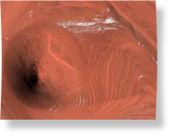
© NASA/JPL/University of Arizona
A
trough carved by erosion in Mars' north polar region. The conical mound
indicates a buried crater underneath the ice-rich soil.
A
trough carved by erosion in Mars' north polar region. The conical mound
indicates a buried crater underneath the ice-rich soil.
New
images taken by NASA's Mars Reconnaissance Orbiter have revealed rare
evidence of an impact crater in Mars' north polar region.
Around the red planet's north pole is a feature called the north polar layered deposits, which are a series of ice-rich layers deposited over time and up to several kilometers thick.
The new images from MRO's
High Resolution Imaging Science Experiment (HiRISE) camera revealed an
odd, solitary hill rising part-way down an eroding slope of the layered
terrain.
The exposed section of the deposits is about 1,640 feet (500
meters) thick, and the conical mound is about 130 feet (40 meters)
high.
"The mound may be the remnant of a buried impact
crater, which is now being exhumed," said HiRISE team member Shane
Byrne, of the University of Arizona.
If it sounds backwards for a crater to be revealed by a mound, there's a fairly simple explanation:
The crater formed as the north polar ice layers were being
deposited. The crater itself would have been filled in by ice after it
formed.
Most of these craters are buried under the Martian surface and
inaccessible to scientists and their instruments. But this crater and
its associated ice mound were exhumed as erosion formed a trough above
and around it.
"For reasons that are poorly understood right now, the ice
beneath the site of the crater is more resistant to this erosion, so
that as the trough is formed, ice beneath the old impact site remained,
forming this isolated hill," Byrne said.
At high resolution, the HiRISE image shows that the mound is made up of polygonal blocks as big as 33 feet (10 meters) across.
The blocks are covered by the reddish dust that is ubiquitous
on Mars, but otherwise resemble ice-rich blocks seen in other images of
the north polar layered deposits.
Another new HiRISE image showed a small impact crater on the surface of Planum Boreum, or the north polar cap. This smaller crater is only about 125 yards (115 meters) in diameter.
The dearth of craters around Mars' north polar region has led
scientists to suggest that either the north polar cap is only about
100,000 years old, and therefore would have accumulated fewer impacts,
or that the craters disappear as the ice relaxes, just as imperfections
in an old window disappear as the glass relaxes.
Anyone
who witnessed a ball of flame streaking across the night sky on
Wednesday evening will be relieved to discover that the end of the
world is definitely not nigh.
UFO spotters, however, may find it something of a
disappointment that the fiery spectacle seen lingering above
Peterborough was certainly not an alien spacecraft crashing to Earth.
Since 6.30pm on Wednesday, The Evening Telegraph has been inundated with calls and e-mails from readers who saw a strange fireball cutting a swath across the heavens for several minutes.
Suggested explanations have varied from the nearly plausible to the
distinctly tongue-in-cheek, including fireworks, tricks of the light
and the result of too much time spent in the pub.
The ET, meanwhile, has been busy trying to get to the bottom
of the mystery, and after consultation with the experts we believe we
have discovered the answer.
The most likely explanation, according to RAF Wittering-based
Met Office weather forecaster and keen astronomer Julian Cooke, is that
it was an "unusually large" meteor.
"Fireballs are meteors or meteorites which are brighter than normal and although they are not common, they are not all that unusual either," he said.
"There has been a meteor shower which was at its maximum on Tuesday, and they do tend to spread over a few days either side.
"Most meteors are the size of a grain of sand or a grape pip, but
occasionally one will be much larger - maybe the size of a golf ball.
"They will burn for much longer or even explode with a flash
in the upper atmosphere, which is why they are easily visible in clear
conditions.
"What you can see is the meteor burning up as it enters the
atmosphere. It is obviously quite a sight but is certainly nothing to
worry about."
Another astronomer, 38-year-old Jason Hart, of Orton Brimbles,
Peterborough, reckons the spectacle could also have been an "iridium
flare" - when the light of the sun hits reflective surfaces on
satellites orbiting the earth, creating a streak of bright, white
light.

© Paul Franks
Regulars at the the Dragon pub watched in amazement as the fireball shot through the sky
Regulars at the the Dragon pub watched in amazement as the fireball shot through the sky
But
if the accounts of regulars and staff at the Dragon pub in Werrington
are to be believed, the phenomenon was more in keeping with Mr Cooke's
fireball explanation.
Pub manager Janek Skutela said: "It looked like a bright
orange ball, and about 20 of us went outside the pub to watch it after
one regular came in and said he could see a UFO.
"At first it shot across the sky really fast but then it went
really slowly before disappearing into the distance. All in all it
lasted about seven or eight minutes.
"We couldn't work out what it was but there were reports of a
similar thing happening a fortnight before. One of our customers saw it
but didn't say anything because he was scared everyone would take the
mickey out of him."
Tina Barnes (42), of Tanglewood, Werrington, spotted the fireball outside the Hodgson Centre next door to the pub.
She said: "At first when I saw the fireball I thought it was a
firework because of the time of year and I was waiting for it to
explode. But it continued to come nearer and nearer until it was above
my head and very visible that it was fire."
Science Daily
Sat, 25 Oct 2008 21:15 UTC
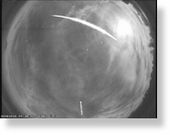
© Western's Southern Ontario Meteor Network, University of Western Ontario
At
05:28 am on Wednesday morning, October 15, all seven cameras of
Western's Southern Ontario Meteor Network (SOMN) recorded a bright,
slow fireball in the predawn sky. In the all-sky view from Orangeville
the fireball passes from upper left (North) to right (West) ending near
the setting moon (the brightest object at upper right).
At
05:28 am on Wednesday morning, October 15, all seven cameras of
Western's Southern Ontario Meteor Network (SOMN) recorded a bright,
slow fireball in the predawn sky. In the all-sky view from Orangeville
the fireball passes from upper left (North) to right (West) ending near
the setting moon (the brightest object at upper right).
For
the second time this year, The University of Western Ontario Meteor
Group has captured incredibly rare video footage of a meteor falling to
Earth. The team of astronomers suspects the fireball dropped
meteorites in a region north of Guelph, Ontario, Canada, that may total
as much as a few hundred grams in mass.
The Physics and Astronomy Department at Western has a network of all-sky cameras in southern Ontario that scan the sky monitoring for meteors.
On Wednesday, October 15 at 5:28 a.m., all seven cameras of Western's Southern Ontario Meteor Network recorded a bright, slow fireball in the predawn sky.
Associate Professor Peter Brown and Phil McCausland, a postdoctoral
researcher in Planetary Science, are hoping to enlist the help of local
residents in recovering one or more possible meteorites that may have
crashed.
"This event was a relatively slow fireball that made it far
into the Earth's atmosphere. Most meteoroids burn up by the time they
hit an altitude of 60 or 70 kilometers from the ground," explains
McCausland, who is heading to the region next week to investigate.
"This one was tracked by our all-sky camera network to have penetrated
to an altitude of about 37 kilometers and it slowed down considerably,
so there is a possibility that at least one and possibly several small
meteorites made it to the ground."
By knowing the trajectory from the camera observations, the
researchers can also track backwards to get the orbit of the object
before it hit the Earth.
"The meteorite was on a typical Earth-crossing asteroid-type
orbit, so we also expect that it is a stony-type meteorite," says
McCausland.
In March, the network of all-sky cameras captured video of a
meteor falling to Earth that may have crashed in the Parry Sound area.
Videos are available at aquarid physics.
Hearing about another fireball meteor, this one spotted last evening in
the northeastern sky. Here's a report from Bowley's Quarters, in
eastern Baltimore County. Did anyone else spot this one?
"Hi there, last night about 7pm I believe - Bowleys Quarters- there
was an amazing fireball I saw through clouds traveling north in the
north eastern sky. I haven't seen anything else on this- I know meteors
are common but this was so bright and through the clouds I was amazed.
Have you heard anything on this? Thanks, Marcie"
There were more reports of a similar fireball over Colorado at around
7:00 p.m. Mountain Time last night. Not the same event, obviously, but
here's a description from an observer named Thomas Ashcraft, in New
Mexico, clipped from meteorobs.org:
"I am pleased to report that I just eye-witnessed a major fireball
event out my window. This fireball was traveling east to west, possibly
over central Colorado. It was long trailed, turquoise and green, and
shed sparks ... It looks like this fireball may have been at least 300
miles north of my location."
The skies over Northwest Kansas Tuesday night were like a scene from a
science fiction movie. A bright light sped across the sky, followed by
a loud explosion. Osborne County Sheriff Curtis Miner tells KSAL News
that it was not an unidentified flying object, or anything sinister. It was a large meteor.
The Sheriff says that the meteor entered the atmosphere, and as it
burnt it broke up into three pieces. It also broke the sound barrier,
causing a sonic boom that shook homes in Osborne.
According to Miner, the National Weather Service Office in Hastings, Nebraska, also received reports of the meteor.
No one was hurt, and their were no reports of damage. The Sheriff adds that pieces of the meteor have not been recovered.
This fireball occurred at 7:29 PM MDT over central Colorado. I have
received over 100 witness reports, from Casper, WY in the north,
Albuquerque, NM is the south, the Western Slope to the west, and the
Front Range to the east.
Data has been recovered from the following Network cameras:
* Cloudbait (details, video)
* Douglas County H.S. (video)
Tom Ashcraft also captured this meteor from his camera near Santa Fe, NM (video and other information).
The image at left is from the Cloudbait camera. The meteor is seen
passing almost straight overhead. It burned continuously, but where it
passed behind thicker clouds at the center the computer briefly
stropped recording.
Based on data from the cameras, the meteor appeared over
Colorado Springs, CO and traveled due west, ending near Cedaredge, CO.
The ground path was about 270 km (170 miles) long, and the average
speed was 34 km/s (76,000 mph).
If you saw this event and have not made a report, please do so here.
Please check back for further information as it becomes available.
Meteorites that are among the oldest rocks ever found have provided new
clues about the conditions that existed at the beginning of the solar
system, solving a longstanding mystery and overturning some accepted
ideas about the way planets form.
The ancient meteorites, like disk drives salvaged from an
ancient computer, still contain magnetic records about the very early
history of planets, according to research by MIT planetary scientist
Benjamin P. Weiss.
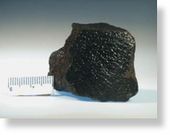
© Maria Zucolotto (Museu Nacional; Brasil)
A
picture of the first discovered (and therefore eponymous) angrite
"Angra dos Reis"; which was observed to fall from the sky in 1869 near
the town of Angra dos Reis in Brazil. The black; shiny face was
produced from melting of the meteorite's surface during passage through
Earth's atmosphere. Scale bar is in centimeters.
A
picture of the first discovered (and therefore eponymous) angrite
"Angra dos Reis"; which was observed to fall from the sky in 1869 near
the town of Angra dos Reis in Brazil. The black; shiny face was
produced from melting of the meteorite's surface during passage through
Earth's atmosphere. Scale bar is in centimeters.
Weiss, the Victor P. Starr Career Development Assistant Professor
of Planetary Sciences in the Department of Earth, Atmospheric and
Planetary Sciences, and his five co-authors examined pieces of three
meteorites called angrites, which are among the most ancient rocks
known. The results of their study are being published in Science on Oct. 31.
The analysis showed that surprisingly, during the formation of the
solar system, when dust and rubble in a disk around the sun collided
and stuck together to form ever-larger rocks and eventually the planets
we know today, even objects much smaller than planets - just 160
kilometers across or so - were large enough to melt almost completely.
This total melting of the planet-forming chunks of rock,
called planetesimals, caused their constituents to separate out, with
lighter materials including silicates floating to the surface and
eventually forming a crust, while heavier iron-rich material sank down
to the core, where it began swirling around to produce a magnetic
dynamo. The researchers were able to study traces of the magnetic
fields produced by that dynamo, now recorded in the meteorites that
fell to Earth.
"The magnetism in meteorites has been a longstanding mystery,"
Weiss said, and the realization that such small bodies could have
melted and formed magnetic dynamos is a major step toward solving that
riddle.
Until relatively recently, it was commonly thought that the
planetesimals - similar to the asteroids seen in the solar system today
- that came together to build planets were "just homogenous, unmelted
rocky material, with no large-scale structure," Weiss said. "Now we're
realizing that many of the things that were forming planets were
mini-planets themselves, with crusts and mantles and cores."
That could change theorists' picture of how the planets
themselves took shape. If the smaller bodies were already molten as
they slammed together to build up larger planet-sized bodies, that
could "significantly change our understanding" of the processes that
took place in the early years of the nascent planets, as their internal
structures were forming, Weiss said. This could have implications for
how different minerals are distributed in the Earth's crust, mantle and
core today, for example.
"In the last five or 10 years," Weiss said, "our understanding
of the early history of the solar system has undergone a sort of
mini-revolution, driven by analytical advances in geochemistry. In this
study we used a geophysical technique to independently test many of
these new ideas. "
"Events happened surprisingly fast at the beginning of the
solar system," he said. Some of the angrite meteorites in this study
formed just 3 million years after the birth of the solar system itself,
4,568 million years ago, and show signs that their parent body had a
magnetic field that was 20 to 40 percent as strong as Earth's today.
"We are used to thinking of dynamo magnetic fields in rocky bodies as
uncommon phenomena today. But it may be that short-lived planetesimal
dynamos were widespread in the early solar system."
The paper was co-authored by Mitsui Career Development
Assistant Professor of Geology Linda Elkins-Tanton, research scientist
Eduardo A. Lima, postdoctoral researcher Laurent Carpozen, student
James S. Berdahl, and Sabine Stanley, assistant professor of physics at
the University of Toronto. The work was supported by a grant from the
National Science Foundation's Instrumentation and Facilities Program.
Adapted from materials provided by Massachusetts Institute of Technology.
Sioux City Journal
Fri, 31 Oct 2008 08:21 UTC
Danbury, Iowa -- Officials aren't sure what caused the mysterious
explosion reported by residents in three counties, but they believe it
wasn't of this earth.
"The whole house shook," said Lois Vanderbur of rural Mapleton. "We thought a tree had fallen on the house."
Woodbury County Sheriff Sgt. Doug Boetger said the explosion was
reported after 8 p.m. Tuesday by residents near the cities of Mapleton
and Danbury as well as in Ida County.
Deputies searched for evidence of an explosion or crash, but
came up empty. Their only suggestion is to look to the sky, Boetger
said.
"We found nothing damaged (and) no signs of an explosion, so we're assuming it was a sonic boom by a passing jet," he said.
Airplanes flying faster than the speed of sound can cause a sonic boom.
Today, Boetger said officials don't know what kind of plane could cause a sonic boom or where such a plane would have come from.
"They didn't come from Danbury, I can tell you that," Boetger said.
Several Air Force and Air National Guard bases are scattered across the region, but none took credit for Tuesday night's noise.
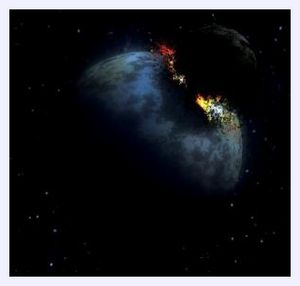
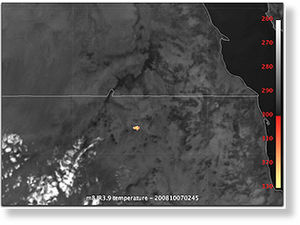
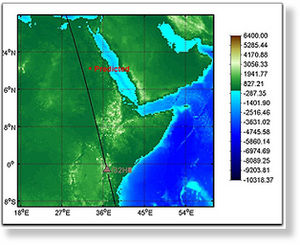

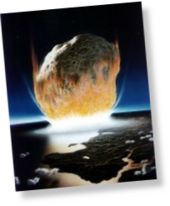
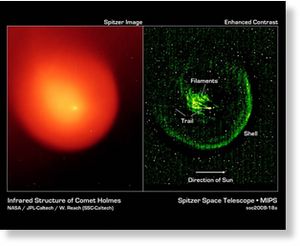

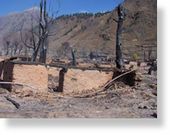
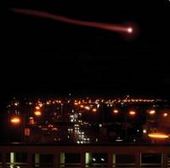
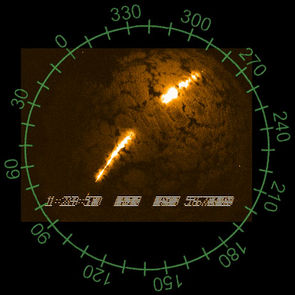
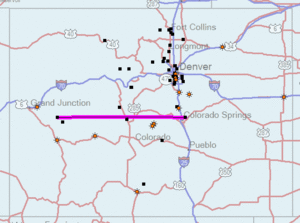
1 comment:
Yes dear
You know very well, Solar system depends on the platinum and iridium material,all the material depends on the earth.....................
Face Painting Calgary
Post a Comment